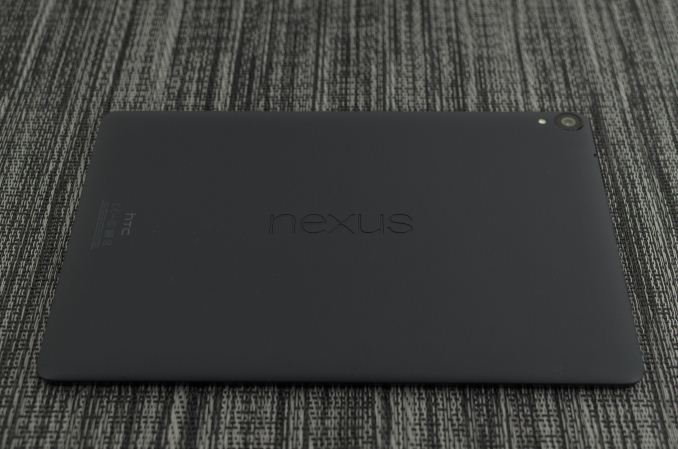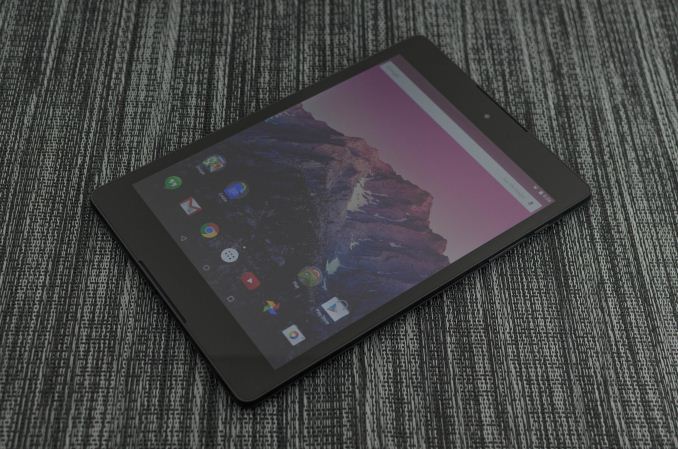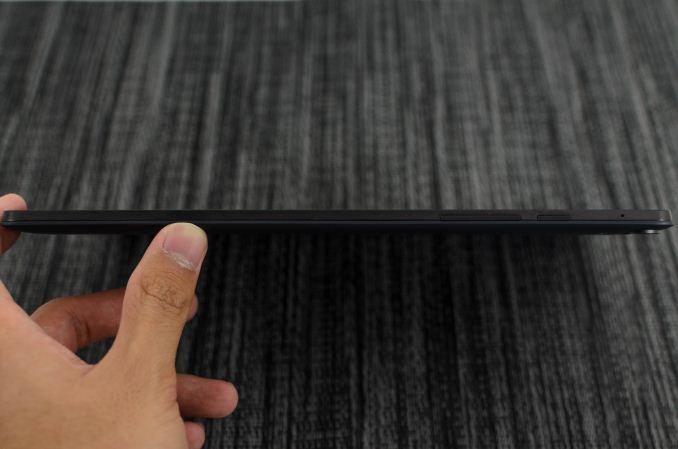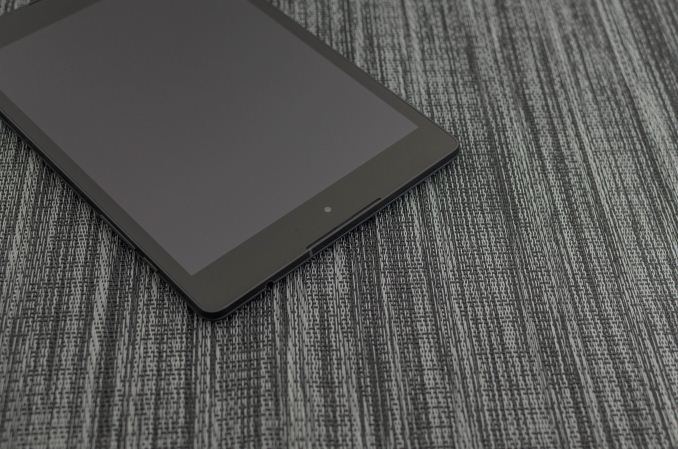Google Nexus 9: Preliminary Findings
by Joshua Ho on November 3, 2014 1:00 PM EST
For a few years now, Google has had a generally consistent tablet strategy. Instead of chasing after the ~10 inch tablet segment and focusing upon the high end, we’ve seen tablets closer to the ~7 inch display size at extremely low cost. While this has been an immensely successful strategy in driving hardware adoption, the formfactor made it possible for the tablet to be closer to a large phone than a small tablet. The flexibility of Android’s scaling system meant that an app designed for a phone worked acceptably well for a small tablet, even if the space efficiency was a bit poor. There’s no question that the Nexus 7 (2013) was and still is a great tablet, but even now it’s obvious that there’s a dearth of applications designed specifically for the larger display. The other issue is that of cost. With the Nexus 7 line, Google managed to integrate an incredible amount of hardware into a tablet priced well below the ~500 USD price point that the original iPad established. This is great for the consumer and no doubt great for Google, but the Nexus 7 line was good enough that there wasn’t much in the way of competition.
This brings us to the Nexus 9, Google’s attempt at changing the Android tablet space. From the start, this device seems to be intent on pushing the Android tablet to a more premium segment. Rather than a purely cost-optimized polymer design, we see the addition of an aluminum ring that runs around the side of the device, which definitely helps with in-hand feel. The tablet itself seems to have high-end aspirations as the launch platform for NVIDIA’s Tegra K1-64, which has two Denver CPU cores rather than the traditional 4+1 Cortex A15 setup, along with dual front-facing speakers and a large 9” display with 4:3 aspect ratio. I’ve included the basic specs in a spec sheet below, to avoid spending too much time going over the basics.
| Nexus 9 | |
| SoC | 2.3GHz 64-bit dual core Tegra K1 Denver SoC |
| RAM/NAND | 2GB LPDDR3 + 16/32GB NAND |
| Display | 8.9" 2048x1536 IPS LCD |
| Network | WiFi only or 2G / 3G / 4G LTE SKU |
| Dimensions | 153.68 x 228.25 x 7.95mm, 425g WiFi, 436g LTE |
| Camera | 8MP Rear Facing (IMX219) with F/2.4 aperture, 1.6MP FFC (OV9760) |
| Battery | 6700 mAh (25.46 Whr) |
| OS | Android 5.0 Lollipop |
| Connectivity | 802.11a/b/g/n/ac + BT 4.1, USB2.0, GPS/GNSS, NFC |
Unfortunately, in the case of the Nexus 9 while we can make some early observations the version of firmware that we received dates was built on August 29th, and in the time since it’s quite likely that there have been significant changes in all directions. We still don't have a newer build, so all the tests will be done on older firmware. The full review will have final numbers as it will be done using shipping firmware.
At any rate, the hardware of the Nexus 9 definitely fits the bill of a premium tablet. While for the most part every Nexus device in the past year has shared the same industrial and material design elements, HTC seems to have added a few extra touches to differentiate this product from other Nexus devices. The most obvious and prominent of these touches is the metal ring, which has a brushed texture similar to what we saw on the M8.
There are also dual front-facing speakers that flank the display, which are definitely great for video and music content when compared to a single speaker on the bottom or back of the device. However, for the most part the design is very much a Nexus device with its minimalistic design and soft-touch plastic back cover.













146 Comments
View All Comments
shashiiishot2007 - Monday, November 3, 2014 - link
so the conclusion looks like nexus 9 cpu is weaker than ipad air 2 but gpu is equal on the ipad air 2. battery life cannot be compared to ipad air 2 since anandtech still did not review it.chizow - Monday, November 3, 2014 - link
Yep, but keep in mind Apple is leveraging 20nm and 1Bn extra transistors on their A8X, which almost perfectly translates into 50% more CPU (1 extra core from 2 in A8) and 50% more GPU (2 extra Rogue GPU clusters from 4 in A8). So the disparity in CPU perf is easy to explain in any case.I think the Denver K1 did better than expected given early benchmarks had it losing to A8X virtually across the board (except for single-threaded).
Also, you can compare battery life because this Preview is basically an iPad Air 2 preview too as it has all the iPad 2 Air data points including battery life. That's probably the most impressive aspect actually, Google/Nvidia was able to beat iPad Air 2 battery life in a smaller form factor.
blackcrayon - Monday, November 3, 2014 - link
Do we know what the relative sizes of the batteries are? Obviously the iPad is larger but is also thinner.chizow - Monday, November 3, 2014 - link
According to ZD the iPad Air 2's battery is 27.62Wh (actually smaller than iPad Air) while the Nexus 9's battery is 25.46Wh, so yeah while the Air has the bigger screen, it also has the bigger battery and benefit of 20nm on its SoC.I guess it is pretty safe at this point to say, all the rumors about Tegra K1 not being able to do well in a thin tablet form factor while retaining its performance were wholly unfounded. Certainly bodes well for Erista with 20nm and Maxwell next year!
solipsism - Monday, November 3, 2014 - link
It's weird to say it's a smaller form factor to claim the battery life is therefore impressive, when the display size difference is double that of the battery capacity difference.kron123456789 - Monday, November 3, 2014 - link
"This build of Android clearly has AArch64 active, which means that we should be able to directly compare the Nexus 9 to the iPad Air 2 for performance." — Um, no. System is using AArch64, but apps aren't.frostyfiredude - Monday, November 3, 2014 - link
Native third party applications won't be, but the included applications should be for the most part and so will the applications purely run on ART bytecode. Granted, benchmarks will be the most likely to be native and still AARCH32, but some of the tests will be quite fair.kron123456789 - Monday, November 3, 2014 - link
Preinstalled Google Apps maybe AArch64, but all third-party applications are AArch32. ART bytecode doesn't make them 64 bit. BTW, there is no Dalvik in Android 5, so all apps are purely run on ART.toyotabedzrock - Monday, November 3, 2014 - link
I think the android Dev blog said art would compile any non native apps to aarch64 automatically.Samus - Monday, November 3, 2014 - link
They ditched Dalvik? wow, there goes like half of the Play Store ;)